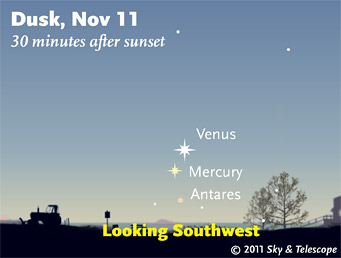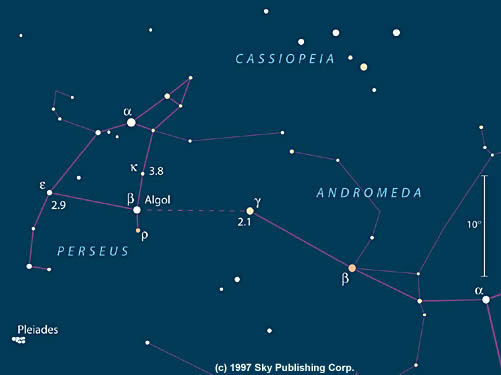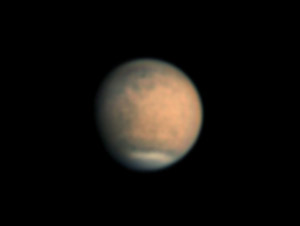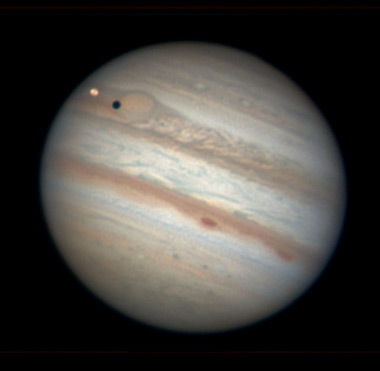
Use binoculars to try for this lineup not long after sunset. The visibility of objects in bright twilight is exaggerated here.
Sky & Telescope diagram
Friday, Nov. 11
Saturday, Nov. 12
Sunday, Nov. 13
To piece out the Andromeda constellation, use the monthly evening sky map in the center of Sky & Telescope. Or, the galaxy is just below the "E" in "Andromeda" on the chart farther below.
Monday, Nov. 14
Tuesday, Nov. 15
Wednesday, Nov. 16
Thursday, Nov. 17

Algol (Beta Persei) was the first eclipsing variable star discovered. Good comparison stars are Gamma Andromedae to its west, magnitude 2.1, and Epsilon Persei to its east, magnitude 2.9.
.
Friday, Nov. 18
Saturday, Nov. 19
Want to become a better amateur astronomer? Learn your way around the constellations. They're the key to locating everything fainter and deeper to hunt with binoculars or a telescope.
For an easy-to-use constellation guide covering the whole evening sky, use the big monthly map in the center of each issue of Sky & Telescope, the essential magazine of astronomy. Or download our free Getting Started in Astronomy booklet (which only has bimonthly maps).
Sky Atlas 2000.0 (the color Deluxe Edition is shown here) plots 81,312 stars to magnitude 8.5. That includes most of the stars that you can see in a good finderscope, and typically one or two stars that will fall within a 50× telescope's field of view wherever you point. About 2,700 deep-sky objects to hunt are plotted among the stars.
Alan MacRobert
Once you get a telescope, to put it to good use you must have a detailed, large-scale sky atlas (set of charts). The standards are the little Pocket Sky Atlas, which shows stars to magnitude 7.6; the larger and deeper Sky Atlas 2000.0 (stars to magnitude 8.5); and the even larger Uranometria 2000.0 (stars to magnitude 9.75). And read how to use sky charts effectively.
You'll also want a good deep-sky guidebook, such as Sue French's new Deep-Sky Wonders collection (which includes its own charts), Sky Atlas 2000.0 Companion by Strong and Sinnott, the bigger Night Sky Observer's Guide by Kepple and Sanner, or the classic if dated Burnham's Celestial Handbook.
Can a computerized telescope replace charts? I don't think so — not for beginners, anyway, and especially not on mounts that are less than top-quality mechanically. As Terence Dickinson and Alan Dyer say in their Backyard Astronomer's Guide, "A full appreciation of the universe cannot come without developing the skills to find things in the sky and understanding how the sky works. This knowledge comes only by spending time under the stars with star maps in hand."
This Week's Planet Roundup

With a diameter of only 6 arcseconds, Mars still isn't much to look at in a telescope. But stacked-video imaging can work wonders. On the morning of November 2nd, Sky & Telescope's imaging editor Sean Walker assembled this shot using a 12.5-inch Newtonian reflector at f/44, a DMK 21AU618.AS video camera, and Astrodon RGB filters.
South is up; the north polar region is at bottom. The Solis Lacus area is near top, foreshortened.
Alan MacRobert
Mercury and Venus (magnitudes –0.3 and
–3.8, respectively) remain 2° or 3° apart just above the southwest horizon in bright twilight. Venus is on top; Mercury, much fainter, is below it. On Friday the 11th look below Mercury to try to spot twinkly Antares, even fainter at magnitude +1.1. Later in the week Mercury moves farther away to Venus's lower right. Bring binoculars or a telescope.
Mars (magnitude +1.0, in Leo) rises around midnight. It's shining close to Regulus, which is nearly as bright at magnitude +1.3 and slightly blue. By the beginning of dawn they're high in the southeast. On the morning of November 12th Mars and Regulus are just 1½° apart. By the 19th their separation widens to 4°, with Regulus on the upper right.
In a telescope Mars is a tiny blob only about 6.4 arcseconds wide. Mars is on its way to a poor opposition next March, when it will reach a width of only 13.9 arcseconds. Still, that's more than twice as big as it appears now.

Io was casting its shadow onto Jupiter's Great Red Spot when S&T's Sean Walker took this image on the evening of November 5th. South is to the upper right. The reddish South Equatorial Belt remains wider (and bicolored) compared to the North Equatorial Belt. Walker used the same imaging setup as for Mars above.
S&T: Sean Walker
Jupiter (magnitude –2.9, at the Aries-Pisces border) blazes high in the east at dusk and higher in the southeast to south later in the evening. In a telescope Jupiter still appears a big 49 arcseconds wide. See our guide to observing Jupiter with a telescope.
Saturn (magnitude +0.8) is low in the east-southeast as dawn begins, a little higher every morning. Spot sparkly Spica (magnitude +1.0) 4½° to its right or lower right. Brighter Arcturus shines far to their left or upper left.
Uranus (magnitude 5.8, in Pisces) and Neptune (magnitude 7.9, in Aquarius) are well placed in the southern sky early in the evening. Use our printable finder chart for both, or see the September Sky & Telescope, page 53.
All descriptions that relate to your horizon — including the words up, down, right, and left — are written for the world's mid-northern latitudes. Descriptions that also depend on longitude (mainly Moon positions) are for North America. Eastern Standard Time (EST) equals Universal Time (also known as UT, UTC, or GMT) minus 5 hours.
NEW BOOK: Sue French's DEEP-SKY WONDERS! This big, long-awaited observing guide by Sky & Telescope's Sue French is now available from Shop at Sky. Hefty and lavishly illustrated, it contains Sue’s 100 favorite sky tours (25 per season, with finder charts) from her 11 years of writing the Celestial Sampler and Deep-Sky Wonders columns for S&T.
To be sure to get the current Sky at a Glance, bookmark this URL:
http://SkyandTelescope.com/observing/ataglance?1=1
If pictures fail to load, refresh the page. If they still fail to load, change the 1 at the end of the URL to any other character and try again.
 0
0
Comments
You must be logged in to post a comment.